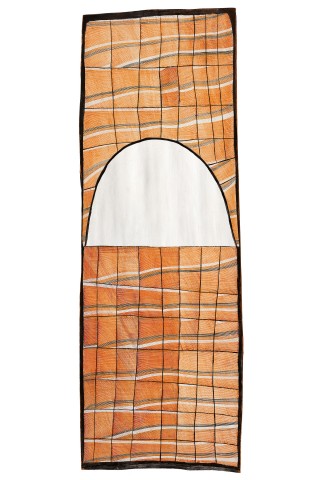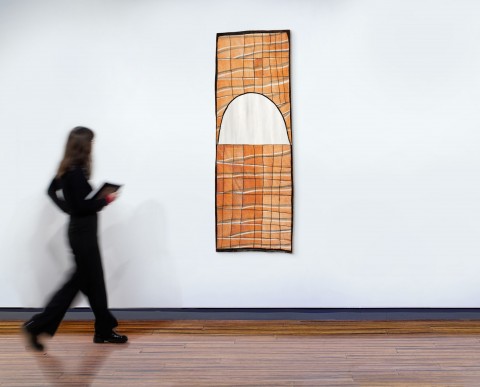BULUWANA AT DILEBANG, 2011
JOHN MAWURNDJUL
natural earth pigments on stringybark (Eucalyptus tetradonta)
185.0 x 65.0 cm (irregular)
bears inscription verso: Maningrida Arts and Culture cat. 2169-11
bears inscription on label verso: artist's name, subject, medium, size, language group and Maningrida Arts and Culture cat. 2169-11
Maningrida Arts and Culture, Maningrida, Northern Territory
Private collection, Sydney
This work is accompanied by a certificate of authenticity from Maningrida Arts and Culture.
One of Australia's most successful and innovative contemporary artists, with an artistic career spanning more than thirty years, John Mawurndjul first achieved recognition in 1981 when he was included in a group exhibition in Paris, Les magicians de la terre at the centre Georges Pompidou. Exhibitions at commercial galleries followed and in 2000, his work was featured in the 12th Biennale of Sydney, followed in 2002 with the bark painting prize at the National Aboriginal & Torres Strait Islander Art Award, Darwin, a prize he won again in 2016.
Born in the freshwater country of Kubukkan near Marrkolidjban, south of Maningrida, an important site for the Kurulk clan and home to the Kuninjku people. Mawurndjul had a very traditional upbringing, guided by his elder brother Jimmy Njiminjuma and his uncle Peter Marralwanga, whose early painting instruction taught him how to apply paint to bodies for dance and initiation ceremonies, a task for which he showed a natural flair. As he recalls, ‘I saw my father doing the rarrk for the Mardayin ceremony and tried to do it myself with my back all doubled over, I ended up being better than any of them at it. They gave me a job in the Mardayin ceremony to paint some rarrk. When they all saw me doing it they said ‘wow’, he’s got the hang of it. ‘You've left us behind my son’, they said to me.’1 Today Mawurndjul guides and monitors the development of his children and his niece Irenie Ngalinba, the daughter of his late brother Jimmy Njiminjuma.
His first paintings on bark were representations of mythological figures, such as Ngalyod the Rainbow Serpent, totemic creatures and local natural species. These early paintings invoke ideas of spirituality, mythology and natural life cycles. It wasn’t until after he had developed a more metaphysical representation of specific sites, events and landscape that Mawurndjul’s fame grew. The artist eliminated representational imagery from his painting and instead embarked upon a journey of exploration of rarrk (lineal clan designs), producing intricate paintings that are encoded with secret meaning. In Buluwana at Dilebang, 2011, the complexity and skill of Mawurndjul’s ability as a painter of rarrk is evident. The central arc, infilled with white clay, represents the head of the ancestor woman Buluwana, who lived at Dilebang and Ngandarrayo in mythological times, and who was killed by the Giant Deaf Adder and turned to a standing stone. Expanses of rarrk with multiple grids rendered in fine interlocking lines, constantly and unpredictably shifting in planes across the surface of the bark surround the central form of Buluwana.
In elevating the treatment of rarrk and the iconic representation of both Mardayin (Sacred) and natural themes, Mawurndjul is constantly finding new ways to interpret his country. As Hetti Perkins notes ‘His works – lovingly crafted and sculpted depictions of flora and fauna, ancestral events, supernatural beings, significant sites and encrypted ceremonial designs – are at once of country and mnemonic of country’2 and as Mawurnjul maintains his paintings are the ‘same, same but different... I just can’t stop thinking about my paintings... They are very important places for us, they have meanings.’3
1. Mawurndjul, cited in Rarrk: John Mawurndjul, Journey Through Time in Northern Australia, Museum Tinguely, Basel, 2005, p. 43
2. Perkins H., ‘Mardayin Maestro’ in John Mawurndjul, I am the Old and the New, op. cit., 2018, p. 26
3. Mawurndjul, cited ibid.
CRISPIN GUTTERIDGE

